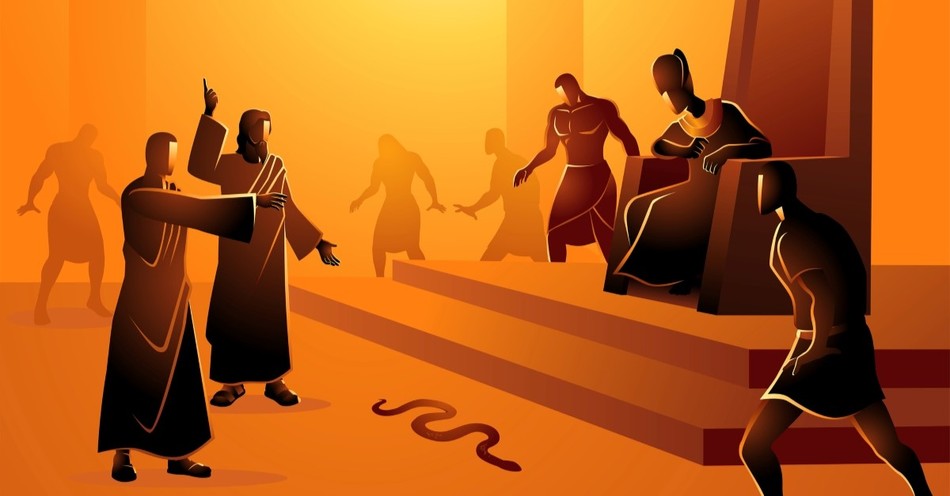Sunday School classes may have told you about the conflict between Moses and Ramses, described as two young men who grew up in Pharoah's household and later fought each other when Moses came to free the Israelites.
The story sounds thrilling, especially since it plays on the theme of sibling rivalry. We see sibling rivalry in various Bible stories—between Cain and Abel, Jacob and Isaac, Joseph and his brothers.
But how accurate is this story about Moses and Ramses?
Which Pharoah Was Named Ramses?
The most famous pharaoh named Ramses in ancient Egypt was Ramses II, also known as Ramses the Great or Ramesses II. Ancient Greek historians called him Ozymandias (you may remember the Percy Shelley poem about a monument to him). His grandfather was Ramses I, and his father was Seti I. While Ramses II is not explicitly named in the biblical account of Moses, many scholars and historians believe he could have been the Egyptian ruler mentioned in the biblical story.
Ramses II, grandson of Ramses I, reigned during ancient Egypt's nineteenth dynasty—around the thirteenth century BCE, corresponding to the general timeframe traditionally associated with Moses and the Exodus. His reign lasted for an impressive 66 years, making him one of Egypt's most influential and long-ruling pharaohs.
The connection between Ramses II and the biblical Moses is primarily based on circumstantial evidence with some historical context. While the Bible does not mention Ramses II by name, it describes the conditions in Egypt during Moses' time—including the Israelites' enslavement, the construction of store cities, and a powerful king's oppressive rule.
The Bible's mention of the city of Pi-Ramesses has led some scholars to associate Ramses II with the pharaoh in the Exodus narrative. Ramses II built Pi-Ramesses as his new capital in the Nile Delta, believed to have been a significant administrative and construction center during his reign. Some argue that this city's association with the biblical story suggests a connection between Ramses II and Moses.
However, it's important to note that scholars still debate whether connecting Ramses II with the pharaoh mentioned in Exodus is correct. The Bible does not mention any Pharoah's name (just "Pharoah"). It often usually doesn't provide an exact timing of events by our standards.
Some scholars propose alternative theories, suggesting that the pharaoh of the Exodus may have been an earlier ruler or from a different dynasty. The lack of direct historical records and the passage of millennia make it challenging to pinpoint the specific pharaoh who interacted with Moses in the biblical account.
What Is 'The Land of Ramses' in the Bible?
"The Land of Ramses" holds significance in the biblical narrative, particularly in the story of the Israelites' enslavement and Exodus from Egypt.
The first mention of The Land of Ramses is in the Book of Genesis, which predates the Exodus account. In Genesis 47:11, during the time of Joseph's prominence in Egypt, Pharaoh grants the land of Goshen to Joseph's family:
"So Joseph settled his father and his brothers and gave them a possession in the land of Egypt, in the best of the land, in the land of Rameses, as Pharaoh had commanded."
However, "The Land of Ramses" is most prominently associated with the later period of Israelite enslavement and the events leading up to the Exodus event. This association is found in the Book of Exodus, which recounts Moses's life and how God chose him to liberate Israelites from Egyptian bondage.
The most significant mention of The Land of Ramses occurs in Exodus 12:37-38:
"And the people of Israel journeyed from Rameses to Succoth, about six hundred thousand men on foot, besides women and children. A mixed multitude also went up with them, and very much livestock, both flocks and herds." (ESV)
In this passage, The Land of Ramses is the starting point of the Israelites' Exodus journey. It was the land they lived in during their enslavement—probably where the city of Pi-Ramesses was located. From here, they began their trek towards freedom in the Promised Land.
The mention of a "mixed multitude" indicates that not only the Israelites left the Land of Rameses. Others who lived in Egypt or were associated with them joined. Scholars like Michael A. Harbin have argued that the fact Moses took an ethnically mixed group (mostly Israelites, but also non-Israelites who wanted to join them) into the desert means God did something key at Mt. Sinai: it meant that regardless of their ethnicity, God was making them all members of one nation.
Who First Suggested that Moses and Ramses Grew Up Together?
The notion that Moses and Ramses grew up together as foster brothers in ancient Egypt has been popularized in various adaptations and retellings of the biblical story of Moses.
One of the earliest and most influential sources to present the idea of Moses and Ramses growing up together as foster brothers is the 1956 epic film The Ten Commandments, directed by Cecil B. DeMille. This cinematic adaptation of the biblical story starred Charlton Heston as Moses and Yul Brynner as Ramses. The film depicts Moses and Ramses as close friends and foster brothers raised together in Egypt's royal court. The foster-bother history adds dramatic tension to their later confrontations as adults when Moses returns to Egypt to challenge Ramses' rule and demand the liberation of the enslaved Israelites.
While this concept was not a direct invention of Cecil B. DeMille, his film gave it a prominent and enduring place in popular culture. DeMille drew from various sources, including the biblical account in the Book of Exodus and historical records from ancient Egypt, to construct his interpretation.
The idea of Moses and Ramses growing up as foster brothers has since become a recurring theme in adaptations of the Moses narrative. Various novels, television series, and other films have followed a similar narrative structure, often emphasizing the close bond between Moses and Ramses during their youth, including the animated film The Prince of Egypt.
The Bible paints a less detailed picture of Moses and the pharaoh he confronts. It mentions one Pharaoh's daughter taking him out of a basket in the Nile River and that he grew up in the royal household. Specific details (whether he grew up with Ramses or a different Egyptian prince, how they related to each other) do not appear.
The notion of Moses and Ramses as foster brothers serves as a dramatic device to enhance the storytelling and character dynamics in adaptations of the Exodus narrative. It adds complexity to their later interactions and conflicts, emphasizing the personal dimension of their rivalry as they find themselves on opposing sides of the liberation of the Israelites.
What Makes the Moses and Ramses Theory Complicated?
The following factors explain why many scholars believe Moses confronted Ramses II when he returned to Egypt and why the discussion becomes complicated.
- The Biblical Timeline. The Bible provides a general timeline of Moses' life and events. According to the biblical account, Moses was born when the Israelites were enslaved in Egypt. Pharaoh's daughter adopted him, and he grew up in the Egyptian royal court. After fleeing Egypt following an altercation, Moses spent 40 years in Midian before returning to Egypt as God's chosen leader to liberate the Israelites.
- The Reigns of Pharaohs. Ancient Egyptian history is complex, with many dynasties and pharaohs. Identifying the exact pharaohs during the time of Moses has been challenging for historians. One obstacle in Egyptian history is how new dynasties and pharaohs would rewrite and reframe history to make themselves appear more glorious and greater than any other. This makes Egyptian history incredibly difficult to do with confidence. While some have proposed theories, there is no consensus on the historical identities of the pharaohs in the Exodus story.
- The Ramesside Period. The association between Moses and Ramses is largely based on the mention of "The Land of Ramses" in the biblical narrative (Exodus 12:37). This reference has led to the assumption that Ramses II, also known as Ramses the Great, was the pharaoh of the Exodus. Ramses II ruled during the 13th century BC, aligning with the Exodus's general timeframe as traditionally understood.
- Long Reigns. Pharaohs in ancient Egypt often had long reigns, sometimes spanning several decades. Ramses II, for example, ruled for over six decades. This lengthy reign poses a challenge when attempting to determine who was the pharaoh of Moses' youth and the pharaoh he confronted upon his return. It is hard to say whether the same pharaoh would have ruled for such an extended period.
What Does Moses' Return Tell Us about the Moses and Ramses Theory?
Alongside the fact that the Bible leaves it unclear whether Moses grew up with Ramses II, another dilemma may complicate this theory: Moses did not spend a few short years away before returning to Egypt.
The Bible states that Moses is 40 years old when he murders an Egyptian and leaves the country (Acts 7:23). He is 80 years old when he returns to Egypt (Exodus 7:7). A great deal can happen in 40 years—enough time for two generations of pharaohs to pass. The pharaoh that Moses confronts could have been Ramses II. However, even if he was ruling when Moses returned, Ramses II may not have grown up with Moses. He could have been the son of whichever Egyptian prince Moses grew up with.
Since Moses was raised in Pharaoh's household, he likely knew the leaders at the time, and they were aware of him. Even if Ramses II was too young to grow up with Moses, he may have met Moses as a young child or remembered hearing about an Israelite his father grew up with. They would have had some information about each other, even if they had no close personal history.
Given these facts, it's not unreasonable to assume some personal relationship existed between Moses and the pharaoh he opposed when God sent him to deliver the Israelites from slavery. It's likely, though not conclusive, that he confronted Ramses II. While it is an informed claim, we must admit we can't know for sure. Creating a possible encounter can tell a good story, but we should be clear we are doing so for storytelling purposes, not because the Bible expressly states the claim.
Photo Credit: © Getty Images/rudall30

This article is part of our People of Christianity catalog that features the stories, meaning, and significance of well-known people from the Bible and history. Here are some of the most popular articles for knowing important figures in Christianity:
How Did the Apostle Paul Die?
Who are the Nicolaitans in Revelation?
Who Was Deborah in the Bible?
Who Was Moses in the Bible?
King Solomon's Story in the Bible
Who Was Lot's Wife in the Bible?
Who Was Jezebel in the Bible?
Who Was the Prodigal Son?



